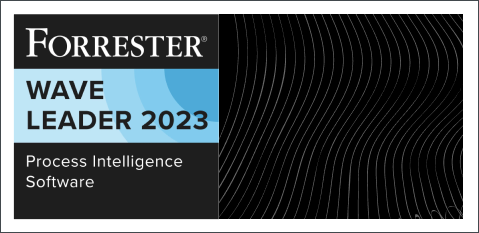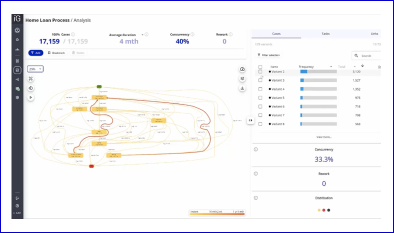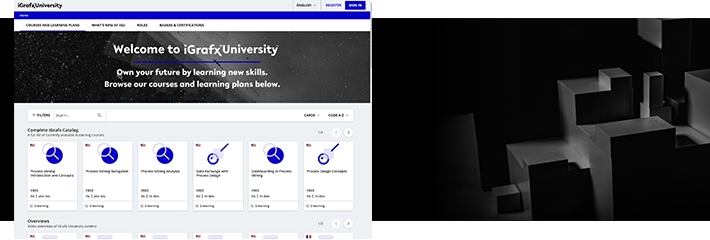Did you know that operational inefficiency costs the average company 20-30% of its annual revenue? While businesses in all sectors face high competition, tools and applications streamline and automate specific processes.
The big question is, are you optimizing your operations to ensure efficiency?
Data analysis is critical to uncovering vital insights about your processes and identifying areas for improvement. Process and task mining enhance operational efficiency and enable you to make changes to improve your bottom line.
If you work with complex processes, task and process mining can be invaluable. In this guide, we’ll explore how each works and the key differences.
What is Process Mining?
Process mining is a proven method for mapping end-to-end business processes using data gathered from event logs. Every time an employee completes an action on an IT system, it leaves a digital footprint, and process mining tools collect this data.
They accurately show the steps involved in each process, creating an ‚as-is‘ picture of how it’s performed and then comparing it to desired processes.
Once you have this information, you can make strategic designs that eliminate operational inefficiency and streamline various processes.
What insights does process mining provide?
Process mining offers a range of valuable insights, enabling you to flag any issues and implement solutions. Let’s explore what process mining can do for your business:
- Variations: Large companies often have numerous departments, and many might use the same processes. The software will evaluate each department and identify whether there are deviations from the workflow. It also enables you to implement standard procedures across the entire company.
- Bottlenecks: Process mining helps you identify bottlenecks – where processes become stuck or take longer than necessary. Once you have this information, you can take steps to remove bottlenecks.
- KPIs: If your business isn’t meeting KPIs, understanding each business process will isolate areas for concern and identify resource issues. This will ensure you can allocate the correct resources to each department, avoiding future problems.
- Compliance: Compliance is a significant worry for companies, but the ability to study each end-to-end process can flag workflow deviations.
- Automation Opportunities: Repetitive tasks can waste a lot of time and resources. Robotic Process Automation (RPA) can streamline these tasks, allowing departments to focus on other areas.
- Customer Journey: Providing a seamless customer journey is key to retention rates. As reported by Empilfy, 86% of customers leave a brand after two negative experiences. Process mining identifies weaknesses in customer relationship management, enabling improvement opportunities.
What is task mining?
While process mining examines a company’s entire operations, task mining assesses how individual tasks contribute to an entire process. It often collects data from employee systems, including keystrokes, clicks, application open events, and the time an employee takes to use applications.
Task mining software isolates productivity issues by giving employers granular insights into the steps employees take when completing tasks. Every company knows its workforce will define its success, but low productivity levels continue to result in lost revenue yearly.
Implementing task-mining solutions can isolate areas for improvement, resulting in a more productive workforce.
What insights does task mining provide?
Task mining concentrates on individual tasks, which allows it to gather numerous insights for businesses, including:
- Repetitive Task Identification: The software identifies repetitive tasks by analyzing activity data. Decision-makers can streamline specific tasks by implementing automation, freeing up employee time.
- Compliance Monitoring: The finance, healthcare, and other highly regulated industries must follow strict compliance rules. Task mining enables companies to assess whether individuals are adhering to procedures.
- Training Needs: One of the most important benefits of task mining tools is their ability to highlight tasks that cause hesitation. This gives employers an excellent opportunity to implement training and eliminate knowledge gaps.
- Resource Allocation: While some employees complete tasks quickly, others require more time. By seeing how long it takes someone to perform a task, businesses can refine allocations to maximize productivity.
The main differences between process mining and task mining
Both process and task mining can be beneficial for companies of all sizes. However, each has a unique purpose, and understanding the differences can help you make the right decision for your needs. With that in mind, let’s compare both mining techniques in more detail.
Individual vs end-to-end processes
Recording individual tasks has benefits, but the information you gather will always be limited. While task mining can help you review individual key performance indicators, process mining enables you to identify opportunities across an entire business.
Task mining is often a process discovery component, enabling a comprehensive understanding of operational efficiency during process mining.
Collecting data
Mining can only be successful with a comprehensive data procurement process. Both process and task mining rely on data analysis, but each collects information from different sources. Process mining uses event logs from IT systems, while task mining collects data from screen recordings and user activity.
Collecting individual data provides insights into behavior, but accessing event logs offers an in-depth look at company operations.
Insights and opportunities
Implementing end-to-end process improvement strategies can enhance an entire company’s operations, leading to higher ROI and customer retention rates. Task mining provides feedback on how individuals work, enabling decision-makers to refine systems.
Both have benefits, but task mining can only provide limited insights, while process mining enables cross-departmental changes.
The similarities between task mining and process mining:
Optimization: Both task and process mining have the same goals: optimizing workflows and enhancing operational efficiency. Process mining provides a complete picture.
Data Driven: Data collection is intrinsic to both techniques, with process mining recording each system event and task mining relying on desktop data or other individual devices.
Automation Opportunities: Both techniques isolate key areas for automation, resulting in significant cost savings.
Enhancing Experience: Whether improving the employee experience or enhancing customer satisfaction rates, the two techniques give decision-makers a comprehensive view of bottlenecks.
When should I use process or task mining?
Implementing both task and process mining into your business can be hugely beneficial in gaining a better understanding of your company’s operations. When deciding which to implement, it’s important to consider your immediate and long-term needs.
Let’s explore some use cases for both techniques:
Process mining
Process mining software plays a significant role in the continuous digital transformation in helping industries map, manage, and optimize their process. Popular use cases for the technology include:
Financial Sector: Process mining in the financial sector can streamline customer onboarding experiences and maintain compliance across the entire organization. With strict regulations, the software can identify inefficiencies while speeding up loan and mortgage applications.
Healthcare Industry: Patients expect a reputable and streamlined process when accessing healthcare. Implementing process mining solutions can result in process excellence and increased efficiency.
Manufacturing Plants: Production workflows must be seamless in manufacturing plants, but bottlenecks in information systems and supply chain disruption can cause significant issues. Process mining can optimize workflows and uncover inefficiencies throughout departments.
Task Mining
While task mining’s insights aren’t as in-depth, implementing software can benefit your business. Here are some use cases that highlight its abilities:
User Experience (UX): Task mining enables businesses to identify employee pain points, including problems with applications or complex interfaces. These insights can pave the way for improvements that enhance user experience.
Task Efficiency: Implementing solutions for streamlined workflows enables employees to achieve more with their time. The ability to allocate tasks based on each person’s ability can also enhance satisfaction and retention.
Enhancing Accuracy: Data entry is one of the most vital business processes, but it often results in errors. Companies can integrate automation by evaluating user interaction data, reducing costly mistakes, and enhancing employee productivity.
The bottom line
Traditional methods of tackling operational inefficiency can fall short, but task and process mining provides valuable insights into how each action contributes to the bigger picture.
Implementing process mining software gives you a powerful tool to refine processes across your organization. The result? Maximized effieicncy, smoother customer support and the elimination of barriers.
If you’re interested in harnessing the power of process mining tools, please book a free demo with iGrafx today.




